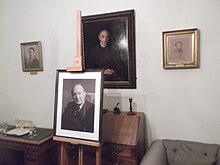E. J. Bowen
Edmund John Bowen | |
|---|---|
Harold Brewer Hartley[3] | |
| Doctoral students | Walter Metcalf |
Edmund ("Ted") John Bowen
Early life and wartime career
E. J. Bowen was the eldest of four born to Edmund Riley Bowen and Lilias Bowen (née Kamester) in 1898 in Worcester, England.[7] He attended the Royal Grammar School Worcester.[7]
He won the Brackenbury Scholarship in 1915 to the
Research career
In 1922, Bowen became a
Created a
Much of Bowen's research work was carried out at the
During May 1931, Bowen, then a University don, attended a series of three lectures given by
As well as chemistry, Bowen also had an interest in
Later life and death
Bowen lived for most of his working life in Park Town[24] and is buried in Wolvercote Cemetery, north of Oxford. Bowen was married to Edith née Moule and they had a son (also a chemist) and a daughter. He died on 19 November 1980 after a short illness.[7]
Bowen room

The room at University College that Bowen used was subsequently named the 'Bowen room'.[25] It was used by Emeritus Fellows of the college and later occupied by Prof. Ruth Chang.[26] Bowen's papers (1931–1980) are held by the Museum of the History of Science in Oxford.[27][28]
Notable co-authors
- Sir Cyril Norman HinshelwoodFRS
- Ronald George Wreyford Norrish FRS
- Nevil Vincent SidgwickFRS
- Sir Harold Warris ThompsonFRS
See also
- Ronnie Bell FRS, a physical chemist and Oxford colleague
- John Albery FRS, colleague and successor at University College, Oxford
- Bowen's son, Humphry Bowen, another chemist[24]
- Bowen's grandson, Jonathan Bowen, a computer scientist[24]
- List of Fellows of the Royal Society elected in 1935
References
- ^ JSTOR 769866.
- Archive.org. Royal Society of Chemistry. 2017. Archived from the originalon 27 August 2020.
- ^ "Academic Genealogy of the NDSU Department of Chemistry, Biochemistry and Molecular Biology" (PDF). North Dakota State University, USA. Archived from the original (PDF) on 11 December 2018. Retrieved 16 March 2012.
- ^ The Clarendon Press. (2nd edition, 1946.)
- ^ required.)
- ^ "Obituary: E. J. Bowen". The Times. 22 November 1980.
- ^ ISSN 0080-4606.
- Lives of the First World War
- doi:10.1038/201180b0.
- ^ "Davy archive winners 1989–1900". UK: Royal Society. Archived from the original on 31 July 2013. Retrieved 20 May 2010.
- .
- ISBN 978-0-85404-139-8.
- S2CID 143194112.
- ^ Bowen, Jonathan P. (29 June 2014). "Chemistry and art (slide 37)". Creative Visualization in Chemistry. SlideShare. Retrieved 2 September 2021.
- University College Record. Vol. V, no. 5. University College, Oxford. September 1965. pp. 308–310.
- .
- ISBN 978-0-300-23476-3.
- Museum of the History of Science. Retrieved 1 December 2013.
- .
- ^ "Fossil specimen : OUM J.04562 – Holotype". GB3D Type Fossils. UK. Retrieved 11 August 2023.
- ^ "Perisphinctes". www.geologypage.com. Geology Page. 21 February 2015. Retrieved 19 February 2018.
- ^ "Ammonite / Perisphinctes boweni / France". Dave's Rock Shop. Archived from the original on 17 December 2017. Retrieved 19 February 2018.
- ^ Czerkaszyn, Danielle (12 August 2021). "Solving a Celestial Mystery: The Sun, Earth and Moon Model". More than a Dodo. Museum of Natural History University of Oxford. Retrieved 2 September 2021.
- ^ ISBN 978-1-899536-25-2.
- Archive.org. UK: University College, Oxford. Archived from the originalon 18 December 2013. Retrieved 13 December 2013.
- ^ "Ruth Chang". UK: University College, Oxford. Retrieved 11 August 2023.
- ^ "Catalogue of the papers and correspondence of EDMUND JOHN BOWEN, FRS (1898–1980)". UK: The National Archives. CSAC 81.5.81. Retrieved 26 March 2024.
- ^ "Papers and correspondence of Edmund John Bowen, 1898–1980". Archives Hub. UK: Jisc. GB 463 MS Bowen. Retrieved 26 March 2024.
External links
- Bowen, E. J. (Edmund John) 1898–1980: Papers, 1921–1980 Archived 24 March 2012 at the Museum of the History of Science, Oxford.
- E. J. Bowen publications[dead link] listed by Microsoft Academic
- Oxford Physical Chemistry: Early days.
- E. J. Bowen books, Open Library.
- Edmund John Bowen photograph by Walter Stoneman (1954) in the National Portrait Gallery, London.
